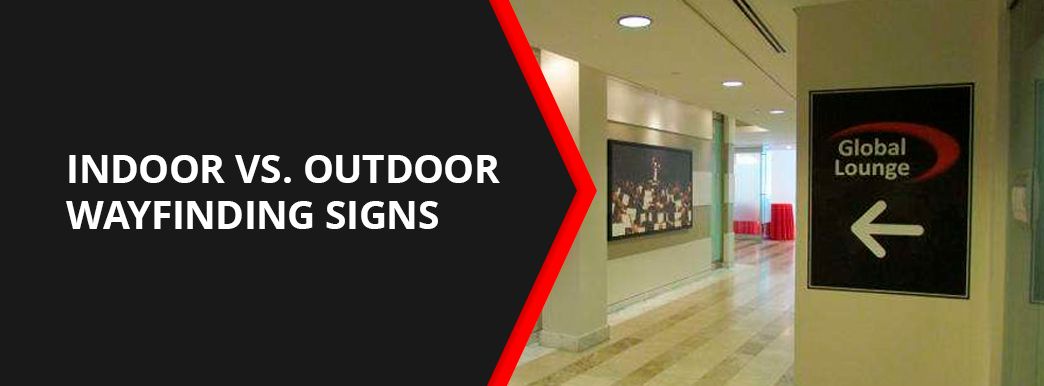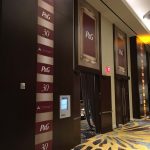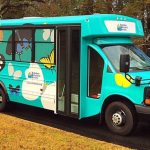
INDOOR VS. OUTDOOR WAYFINDING SIGNS
DECEMBER 10, 2020| SpeedPro Silver SpringCategories
UncategorizedWhen a person visits a business for the first time, they might feel anxious because they are unsure if they’ll be able to make their way to the right place. Wayfinding signage can step in and help people figure out where to go. Both indoor and outdoor wayfinding signage perform this role while the materials they are made of are slightly different.

What are Outdoor Wayfinding Signs?
Outdoor wayfinding signs can take several forms. They can include outdoor signs placed at the entrance of a parking lot or on the lawn in front of a building. The entrance signs might identify the building or business and provide direction to visitors arriving in a car or on foot. Some examples of outdoor wayfinding signs include:
- Pylons: Pylons are large outdoor signs that usually list the names of businesses in a shopping center or office park. They help visitors determine if the company they are looking for is located in a particular shopping area or office complex. Due to their large size, pylons are easy to spot from a distance.
- Banners: Banners are usually attached to a building. They can feature the name or logo of a business and identify the occupant of a building.
- Monument signs: Monument signs are usually tall and skinny. They can identify a location or building, letting a person know if they are in the right spot. They can also serve as directional signs, complete with arrows that point people to their destinations.
- Digital signs: Digital signs can share information with passersby or help people find where they need to go. They are especially useful for changing information, such as limited time promotions or a pop-up store’s location.
- Maps: Maps might be the ultimate example of wayfinding or directional signs as they literally show people where places are in relation to each other. Maps help individuals figure out what turns to make and which direction to head to get where they want to go.

What are Indoor Wayfinding Signs?
Indoor wayfinding signs guide individuals once they’re inside a building. For example, when you visit a mall, there are usually signs directing you in the direction of the anchor stores and the food court. Some examples of indoor wayfinding signs include:
- Directory signs: Many buildings will have a directory located near the stairs, elevators or front lobby. The directory usually lists the building occupants and includes the floor number or room number for them. Some directory signs also include a phone number for each occupant.
- Room plaques: A small plaque by the door of a room lets visitors know if they have found the right spot. Some room plaques list the room number or name and are permanent. Others can be changed based on who is using the room. A digital room plaque can allow for quick updates about the room’s use or identity.
- Floor and hallway markers: Signs placed on the walls of a building can identify the floor number and hallway name to help guide people to the different sections or areas of the building.
- Floor decals: In some cases, floor decals can act as wayfaring signage. The decals can trace a path for people to follow or be in the form of giant arrows that point visitors in the right direction.
- Instructional signs: Some indoor wayfinding signs are for informational purposes. They give people an idea of what’s allowed and where they can go. Instructional signs might tell people not to smoke, let them know a room is off-limits, or ask them to wear a mask, shoes, or shirt.

Benefits of Wayfinding Signage
Because wayfinding signage helps visitors know where to go, they are more likely to feel at ease and less anxious during the visit. Wayfinding signage is great for spaces where people’s emotions are running high so they have an easier time navigating while their focus may be elsewhere.
Differences Between Indoor and Outdoor Directional Signage
Indoor and outdoor signs differ in a few notable ways. Although they both serve the same purpose, the signs are constructed differently. Outdoor wayfinding signs tend to be large and constructed with weather-resistant materials, featuring high-contrast color so it is easier to read in the outdoors. Conversely, indoor signs are able to be constructed with less durable materials and are often smaller than outdoor wayfinding sign.
Turn to SpeedPro Silver Spring for Outdoor or Indoor Directional Signage
Visitors to your business need to know that they’ve found you and know where they’re going once they pass through your doors. SpeedPro Silver Spring can help you create wayfinding signs for inside and outside that put your guests or customers at ease and make it a snap to move around your business.














